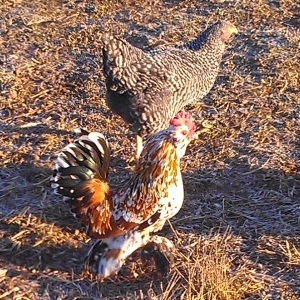
What's in an Egg?
 If you do a little reading of lables in the grocery store, you will quickly notice a wide variety of marketing terms on the packaging of the mass-produced eggs. Some of the common terms you'll see include: cage-free, free-range, organic, vegatarian, and pastured. Of these, the only one that means what you think it means is "pastured". Let's talk about what the others mean.
If you do a little reading of lables in the grocery store, you will quickly notice a wide variety of marketing terms on the packaging of the mass-produced eggs. Some of the common terms you'll see include: cage-free, free-range, organic, vegatarian, and pastured. Of these, the only one that means what you think it means is "pastured". Let's talk about what the others mean.
Free-range
In the US, in order to call an egg free-range, the hen must have access to the outdoors for at least part of the day1. Unfortunately, the "outdoors" can be somewhat loosely defined. If I create a concrete pad and enclose it in wire fencing, it is considered "outdoors" for the purposes of free-ranging my hens. Leaving the coop or barn door open for five minutes a day could also meet the requirement, even if the hen doesn't go out of the open door. The point is that she had access to the outdoors. So the consumer may be thinking of a hen singing Born Free while lounging in lush pasture grass, but the reality is probably a big letdown.
Cage-free
Cage-free eggs come from hens that are not kept in cages. However, these hens can still be raised in very close quarters in a barn roaming system and qualify as cage-free. This designation makes no claim about the type of feed the animal receives, just that they are not kept in cages2
Organic
The organic lable has more to do with what the hen eats than how she is raised. Organic eggs can come from hens kept in cages, so long as they are fed only organic feed. In practice, many organic egg laying operations use a barn roaming system where the hens are cage-free or free-range.
Vegatarian
This is the silliest of all the marketing terms used to sell eggs. Hens are not vegatarian. I have watched hens eat mice, snakes, frogs, and all manner of insects and arachnids. So by labling your eggs as vegatarian, you are just acknowleging that you are feeding the hens something different than what their biology would say is best for them.
Pastured
This is the one lable that usually means what the consumer thinks it means. These birds are free to roam about in the outdoors. This could be just a patch of dirt with a fence around it, or it could mean that they are not enclosed in any way. To be sure, get to know your producer3.
When hens are raised on pasture, they tend to eat more seeds, weeds, grasses, insects, small mammals, and reptiles (when they can catch them). They also have free access to small rocks and grit that they store in their gizzard to grind their food. So pastured birds have better digestion of a broader variety of foods. The result is a more nutritious product. Studies have shown that pastured eggs are higher in Omega-3 fatty acids, folic acid, vitamin B-12, vitamin A, and vitamin E, while having as little as half the cholesterol of factory farmed eggs4.From time to time you will read an article where a reporter claims there is no difference between factory farmed eggs and other types of eggs, but if you read carefully, you will notice that they are usually comparing factory farmed and cage-free or free-range. One study even compared factory farmed and organic5, finding no nutritional difference, which is not surprising. If you don't give chickens access to greens, insects, and natural grit, simply feeding them non-GMO corn will not produce a product with any nutritional advantage.
You might wonder what the nutritional difference looks and tastes like. When you crack an egg into a pan, a high-quality grade AA egg should not spread very far, and the thick part of the egg white should stand up nice and thick.6 Try it sometime with a grade AA egg you buy at the store. I have had them fill the bottom of a frying pan. That's a low-quality product. It may have been high quality when it was graded and packed at the factory farm two months ago, before it was trucked in from out of state and stored until you bought it. Try a farm-fresh egg sometime. I have taken an egg out from under a hen in a nest box and fried it up. The difference is amazing. The taste is noticibly better, the yolk is a deep orange instead of a lemony yellow, and the thick white (the part with the highest concentration of protein) is nice and tall.
So what's in an egg? Quite a bit. Don't believe the marketing. Find out for yourself under what conditions the eggs are being produced. Then try an egg from a small local farmer that pastures his hens. It's worth the time to track them down!
1 Deneen, Sally Free Range Foods (Hearts Communications, 2013.)
2 Nelson, Jennifer Are Some Eggs Safer than Others? (Web M.D., 2010.)
3 Watson, Molly Pastured Eggs (About.com, 2013)
4 Long, Cheryl and Newbury, Umut The Good Egg (Ogden Publications, 2005)
5 Kluger, Jeffrey Organic Eggs: More Expensive but No Healthier (Time Magazine, 2010)
6 USDA Egg Grading Manual (USDA, 2000)